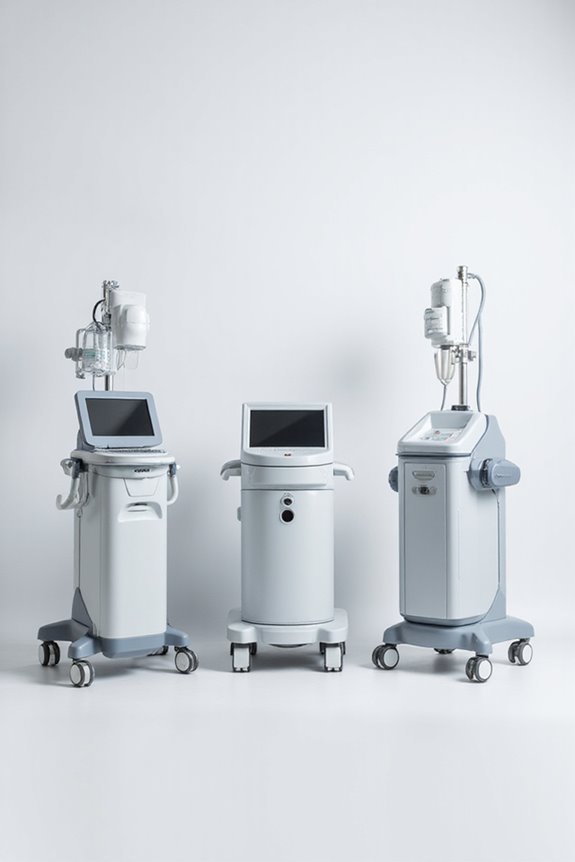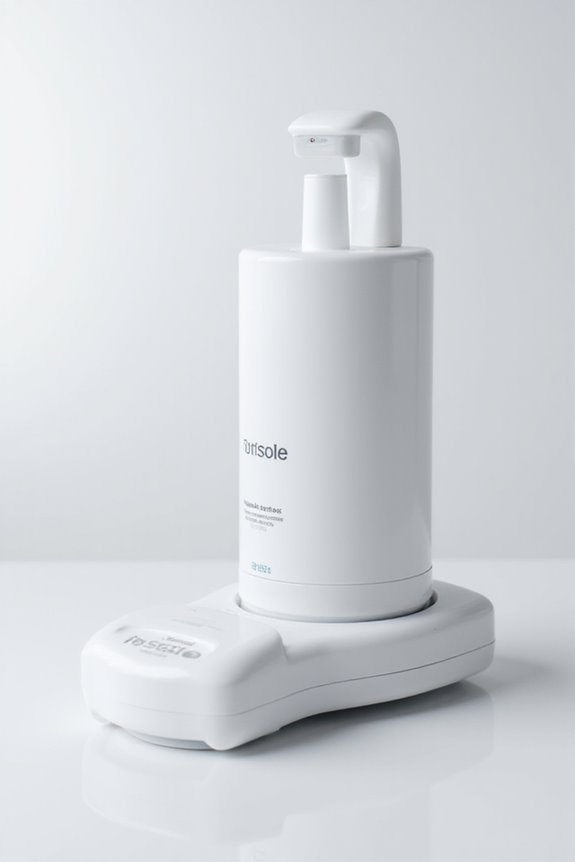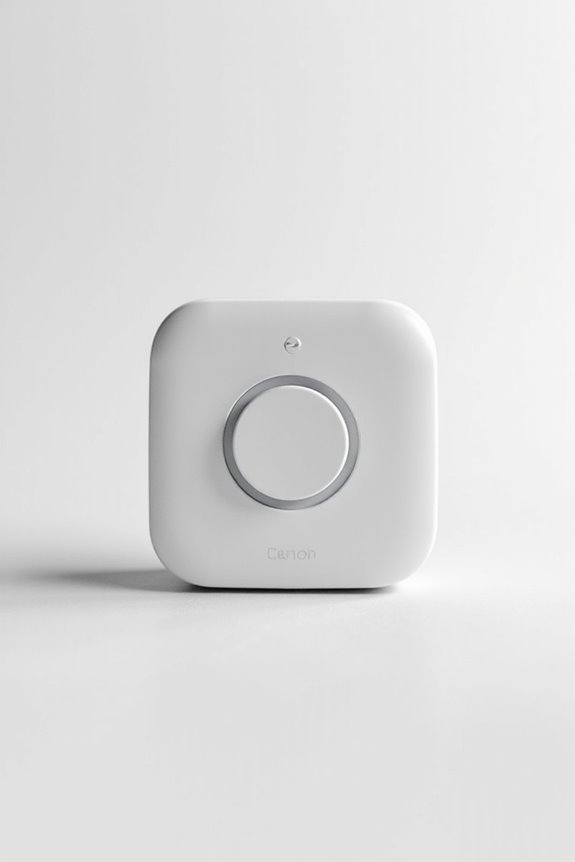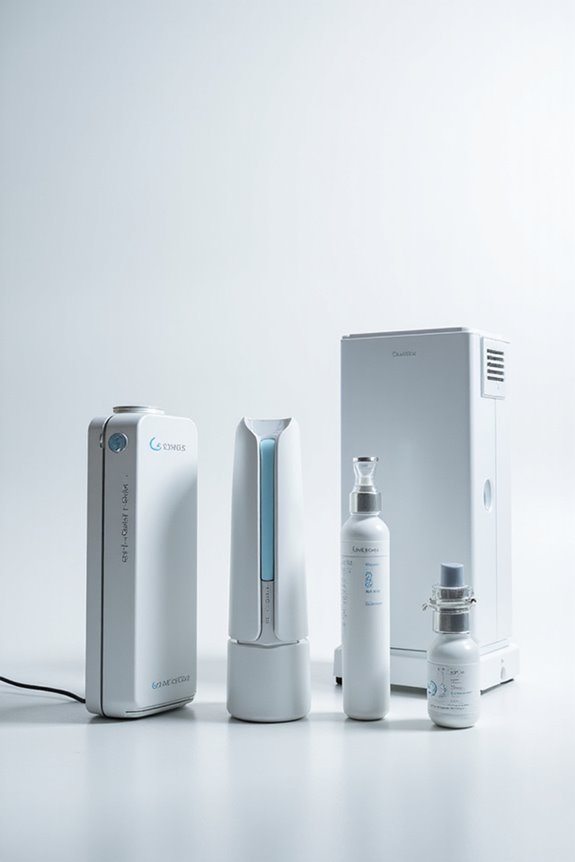Links below are affiliate links. We earn a commission on purchases at no extra cost to you. Although our opinions are based on curated research, we haven't used these products. Articles generated with AI. This article is for informational purposes only and does not constitute medical advice. Please consult a qualified professional for health-related questions.
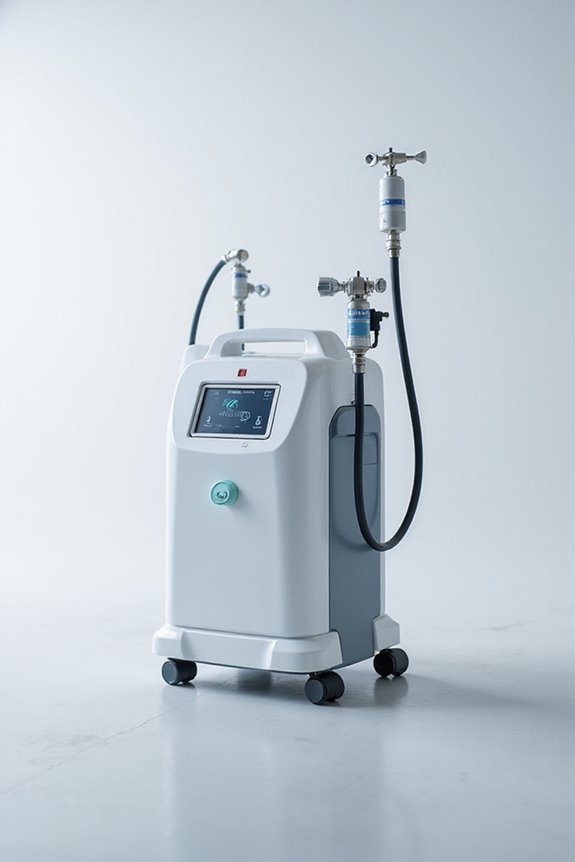
5 Best Personal Oxygen Machines of 2025 – Enhance Your Breathing Experience
To enhance your breathing experience in 2025, consider these top personal oxygen machines:
- Portable Oxygen Concentrator Machine (ROG22): Delivers 1-9L with 96% purity.
- Low Noise Portable Oxygen Machine: Flow rates of 1-9L/min; operates quietly under 40 dB.
- Oxygen Concentrator Machine: Adjustable 1-7L/min with large LED display.
- Portable Oxygen Generator (1-9L Adjustable): Features touch screen controls.
- Oxygen Generator for Home/Travel: Weighs 6.5 lbs with 1.5-3.5 hours battery life. Continue to explore detailed specifications and comparisons.
Key Takeaways
- The ROG22 Portable Oxygen Concentrator offers adjustable flow rates from 1-9L/min with 96% purity for effective oxygen therapy.
- A Low Noise Portable Oxygen Machine combines therapy and nebulization while operating under 40 dB for user comfort.
- An Oxygen Concentrator Machine ensures quiet operation at 48 dB and includes remote control for convenient adjustments.
- The Portable Oxygen Generator provides adjustable flow rates and a user-friendly touchscreen for effortless usage.
- A compact Portable Oxygen Generator for travel offers 93% oxygen purity, lightweight design, and battery life of 1.5 to 3.5 hours.
Portable Oxygen Concentrator Machine (ROG22)
The Portable Oxygen Concentrator Machine (ROG22) is particularly well-suited for elderly users or individuals with limited technological proficiency, as it features a user-friendly design.
Product Features
- Delivers 1-9L of oxygen with 96% purity.
- Compact and modern design, fitting easily into various home spaces.
- Lightweight for mobility around the home.
Ease of Use
- Simple operation with large, clearly labeled buttons.
- Requires minimal setup, ensuring straightforward usability.
Performance
- Operates quietly, enhancing comfort during long-term use.
- Reliable over time with easy maintenance, primarily filter replacements.
Customer Feedback
– Users, especially seniors, report high satisfaction and recommend this device for home use.
Best For: The Portable Oxygen Concentrator Machine (ROG22) is best for elderly users and individuals with limited technological proficiency seeking a reliable oxygen supply at home.
Pros:
- User-friendly operation with large, clearly labeled buttons that simplify flow adjustments.
- Compact and lightweight design allows for easy placement and mobility within the home.
- Quiet operation ensures comfort and minimal noise disruption during long-term use.
Cons:
- Requires regular filter replacements to maintain optimal performance over time.
- Limited oxygen flow rate may not meet the needs of users requiring higher levels.
- Initial cost may be a barrier for some users considering home oxygen solutions.
Oxygen Concentrator, Low Noise Portable Oxygen Machine for Home Use
For those seeking a reliable oxygen source at home, the low noise portable oxygen concentrator is an exceptional choice. Here are the key features:
- Oxygen Output: Flow range of 1L/min to 9L/min, oxygen concentration from 95% to 35%.
- Dual Functionality: Provides both oxygen therapy and nebulizer treatments, with multiple nasal cannulas and masks included.
- User-Friendly Design: Voice mode startup, large LED display, and remote control simplify operation. Instructions are available in five languages.
- Noise Level: Operates at less than 40dB, ensuring minimal disturbance.
- Power Supply: AC110V 60Hz; no batteries needed, reducing device failure risk.
Best For: Individuals needing reliable and quiet oxygen support for home use.
Pros:
- Dual functionality allows for both oxygen therapy and nebulizer treatments, accommodating various health needs.
- User-friendly design features, including a remote control and clear LED display, enhance ease of operation.
- Low noise level, operating at <40dB, minimizes disturbance during sleep or daily activities.
Cons:
- Non-medical device, which may limit its use in clinical settings or for severe medical conditions.
- Dependence on AC power supply may be inconvenient in areas without steady electricity access.
- Limited oxygen concentration range (95%-35%) might not meet the needs of all users requiring specific oxygen levels.
Oxygen Concentrator Machine for Home Use
No products found.
Oxygen concentrator machines designed for home use offer essential benefits for individuals requiring supplemental oxygen therapy.
Key Features:
- Oxygen Output: Adjustable settings from 1-7 liters per minute guarantee a stable oxygen supply tailored to your needs.
- Noise Level: Operates quietly at 48 dB, providing a serene environment for uninterrupted use.
- User-Friendly Design: Equipped with a large color LED screen and remote control for effortless operation.
- Portability: Lightweight design allows for convenient placement on bedside tables for nighttime use.
These features make the oxygen concentrator a crucial tool for enhancing your breathing experience at home.
Best For: Individuals requiring supplemental oxygen therapy who need a reliable and user-friendly solution for home use.
Pros:
- Adjustable Oxygen Levels: Customizable oxygen output settings allow for tailored therapy based on individual needs.
- Low Noise Operation: Runs quietly at 48 dB, making it ideal for use during the night or in quiet environments.
- User-Friendly Features: The large color LED screen and remote control enhance convenience and ease of operation.
Cons:
- Limited to 7L Output: May not be suitable for patients requiring higher oxygen flow rates.
- Dependency on Electricity: Requires a constant power source, which may be a limitation during power outages.
- Portability May Vary: While lightweight, it may still be cumbersome for some users to move around frequently.
Portable Oxygen Generator (1-9L Adjustable)
No products found.
Portable Oxygen Generators with an adjustable flow rate of 1-9L are an excellent choice for individuals requiring diverse oxygen needs.
Product Features
- Flow range: 1-9L, suitable for various applications.
- Low noise operation enhances user comfort.
Control Options
- Two methods: touch screen and remote control.
- User-friendly design caters to all skill levels.
Health Benefits
– Increased oxygen supply aids health and wellness.
Design and Maintenance
- Flexible air duct and durable cover prevent leakage, ensuring reliability.
- Easy cleaning and straightforward maintenance enhance user convenience.
This generator offers portability and comfort for home use, promoting stress-free operation.
Best For: Individuals requiring supplemental oxygen for health and wellness, particularly those at home or with limited mobility.
Pros:
- Low noise operation ensures comfortable use, especially during sleep.
- Adjustable flow rate of 1-9L accommodates various oxygen needs.
- Easy maintenance and cleaning features enhance user experience and reliability.
Cons:
- Portable design might limit usage duration based on battery life.
- Touch screen and remote control may still pose a learning curve for some users.
- Initial investment cost may be a consideration for budget-conscious buyers.
Oxygen Generator, Portable Oxygen Concentrator for Home/Travel
Sale
Oxygen Generator,Portable Oxygen Concentrator for Home/Travel,1-5L Adjustable Portable Oxygen...
- Portable Design Generator--portable and small pack design so that you can easily carry this machine(Pulse flow, suitable for daily oxygen supplementation)
- Gross weight:6.5lb,Dimensions:7*3.5*10in.you can easy operate this portable design machine with one click
- % Oxygen - 93%,Flow rate:1- 5 LPM ,The battery can be used for about 1.5-3.5 hours when fully charged.Equipped with a complete set of accessories
Ideal for individuals requiring a reliable source of supplemental oxygen, the Portable Oxygen Generator is designed with versatility and user experience in mind.
Product Features:
- Oxygen Output: 93%
- Flow Rate: 1-5 LPM
- Weight: 6.5 lb
- Dimensions: 7*3.5*10 in
- Battery Life: 1.5-3.5 hours
Portability:
- Lightweight design, easy to transport
- Suitable for home use and travel, including high-altitude hiking
User-Friendly Operation:
- Accessible for users with no technical skills
- Positive feedback during emergencies
The Portable Oxygen Generator combines efficiency and portability, ensuring peace of mind when you need it most.
Best For: Individuals requiring supplemental oxygen for home use or travel, particularly those with health conditions and needs during emergencies.
Pros:
- Portable and lightweight design makes it easy to transport during travel or outdoor activities.
- User-friendly operation allows individuals with no technical skills to operate the device with ease.
- Effective in emergencies, providing a reliable source of oxygen for conditions such as heart attacks or altitude sickness.
Cons:
- Battery life may be limited, ranging from 1.5 to 3.5 hours which may not suffice for extended use.
- Oxygen flow rate may not meet the needs of all users, especially those requiring higher oxygen concentrations.
- Compact size might mean less oxygen production compared to larger, stationary units.
Factors to Consider When Choosing a Personal Oxygen Machine
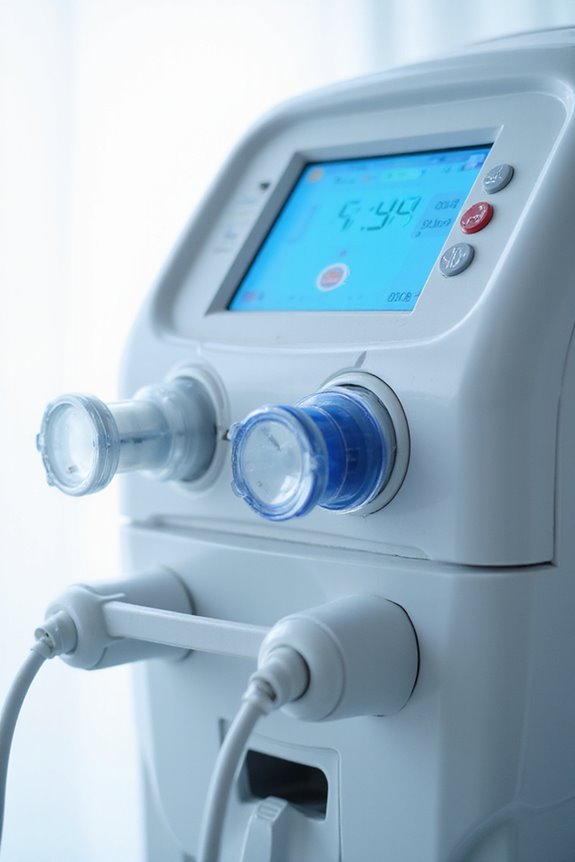
When choosing a personal oxygen machine, it’s crucial to take into account several key factors that can impact your experience. The oxygen flow rate, purity levels, noise level, portability features, and ease of operation all play significant roles in the device’s effectiveness and convenience. Evaluating these elements can help guarantee you select the right option tailored to your specific needs.
Oxygen Flow Rate
Selecting the right oxygen flow rate is crucial for effective respiratory therapy.
- Flow Rate Range: Personal oxygen machines generally offer flow rates from 1 to 9 liters per minute (LPM).
- User Needs: Higher flow rates are critical for more severe respiratory conditions, while those with milder needs may require lower rates.
- Adjustability: A machine with adjustable flow settings enables you to adapt to changing oxygen requirements over time or during various activities.
- Continuous Supply: Most portable oxygen concentrators provide a continuous oxygen supply, ensuring stable output for effective therapy.
Choosing a device with the appropriate oxygen flow rate is fundamental for optimizing your individual therapy experience, enhancing your overall respiratory health and well-being.
Purity Levels
Purity levels play a crucial role in the effectiveness of personal oxygen machines, influencing the overall therapeutic benefit.
- Definition: Purity levels refer to the percentage of oxygen concentration delivered by the machine.
- Optimal Range: Most personal oxygen machines provide oxygen concentrations between 90% to 96%, which are effective for respiratory support.
- Recommendation: A purity level of at least 90% is often necessary for individuals with chronic respiratory conditions to guarantee adequate oxygen supply.
- Caution: Lower purity levels, especially those below 90%, may not meet medical needs and could lead to inadequate oxygenation.
Confirm the purity levels specified by the manufacturer, as they can vary considerably between different oxygen machines. These variations can directly impact treatment efficacy.
Noise Level
Noise levels in personal oxygen machines are a significant factor to contemplate, especially for individuals who require therapy during sleep.
- Quieter models operate below 40 dB, akin to soft ambient sounds like light rain.
- These low-noise machines enhance user comfort and help guarantee uninterrupted sleep, essential for effective therapy.
- Look for models advertising noise levels below 50 dB, as anything above this can disrupt rest.
- Many portable oxygen concentrators minimize operational noise, suitable for both home and travel usage.
- Opting for a quieter oxygen machine not only enhances comfort but also promotes consistent therapy adherence, which is critical for health and well-being.
Portability Features
Portability features are essential when choosing a personal oxygen machine, especially for those who lead active lifestyles or travel frequently. Here are key factors to take into account:
- Lightweight Design: Aim for models under 7 pounds to guarantee easy transport.
- Compact Dimensions: Sizes around 7*3.5*10 inches fit well into backpacks or carrying cases.
- Rechargeable Batteries: Look for units offering 1.5 to 3.5 hours of usage to enhance travel efficiency.
- Durable Casing: A robust design prevents leakage while facilitating cleaning and maintenance.
- Quiet Operation: Devices should operate below 40 dB to minimize disturbance in public spaces.
Prioritizing these features guarantees you select a personal oxygen machine that suits your mobility needs effectively.
Ease of Operation
When selecting a personal oxygen machine, ease of operation plays a critical role in guaranteeing user satisfaction and reliability.
Key factors to take into account include:
- Large, Clearly Labeled Buttons: Look for machines that feature large buttons, making flow adjustments easier, particularly for users with limited technical skills.
- Simple Operation: Choose devices requiring minimal setup and offering straightforward instructions to enhance the user experience.
- User-Friendly Features: Options with remote control or voice mode startup simplify distance adjustments.
- Large LED Display: Guarantee clear visibility of settings and oxygen flow rates, aiding in monitoring.
- Supporting Materials: Select machines with video tutorials or multilingual instructions to facilitate effective operation understanding.
Maintenance Requirements
Maintenance of personal oxygen machines is critical for ensuring their efficiency and longevity. Regular upkeep focuses primarily on filter replacement and cleaning, which manufacturers usually specify. Adhering to the maintenance guidelines in your user manual prevents malfunctions and extends your device’s lifespan.
Key maintenance considerations include:
- Filter Replacement: Essential for peak operation; follow manufacturer recommendations.
- Routine Checks: Inspect components for signs of wear or damage, as these can impact performance and safety.
- Self-Diagnostic Features: Some models come equipped with alerts for maintenance needs, simplifying upkeep.
Power Supply Types
Power supply types considerably influence the functionality of personal oxygen machines. You typically have options like AC power and portable units with batteries.
- AC Power: Most machines operate on standard AC110V 60Hz, meaning you won’t need to replace batteries.
- Battery-operated Units: These provide 1.5 to 3.5 hours of usage when fully charged, enhancing portability for travel or emergencies.
- Portability: Lighter units with battery options are easier to carry on outings.
- Compatibility: Verify the power supply matches local electrical standards for efficient operation without damage risk.
- Maintenance: Machines without batteries reduce maintenance concerns, offering more reliable long-term performance.
Choosing the right power supply type is essential for effective and hassle-free operation.
Additional Functionalities
Selecting the right personal oxygen machine involves considering several additional functionalities that can greatly enhance your user experience.
- Dual Functionality: Look for machines that combine oxygen therapy with nebulizer treatments, promoting thorough health.
- Control Methods: Consider units with various control options, like touch screens and remote controls, for different technical skills.
- Usability Features: Machines with voice mode startups and large LED displays improve accessibility.
- Adjustable Rates: Timers and flow rate settings (1-9L) allow customization to fit individual requirements.
- Noise Level: Evaluate operation noise; models under 40 dB guarantee minimal disturbance, making them ideal for night use.
These factors can greatly influence your comfort and ease of use throughout the oxygen therapy process.
Frequently Asked Questions
How Often Should I Replace the Filters in My Oxygen Machine?
To guarantee peak performance, it’s essential to replace the filters in your oxygen machine regularly. Most manufacturers recommend changing the filters every 30 to 90 days, depending on usage and environmental factors.
Key Points:
- 30 Days: High usage environments.
- 60 Days: Moderate usage.
- 90 Days: Low usage.
Regular maintenance prolongs the machine’s life and enhances air quality, promoting better respiratory health. Follow your device’s guidelines for specific instructions.
Can I Use an Oxygen Concentrator While Traveling on an Airplane?
Yes, you can use an oxygen concentrator while traveling on an airplane, but certain conditions apply:
- Airline Regulations: Check with your airline regarding their specific policies on portable oxygen concentrators (POCs).
- Documentation: Obtain a letter from your physician confirming your need for supplemental oxygen.
- Battery Life: Confirm your concentrator’s battery meets the airline’s requirements for duration during the flight.
- Security Regulations: Be prepared to undergo additional screening at security checkpoints.
Are Portable Oxygen Machines Covered by Insurance Plans?
Insurance Coverage
Portable oxygen machines may be covered by insurance, depending on your specific plan.
Key Factors
- Your medical necessity: A doctor’s prescription often establishes this.
- Type of plan: Medicare, Medicaid, or private insurance may have different policies.
- Documentation: Proper authorization and documentation are usually required.
Check with your insurance provider for specifics regarding coverage limits and potential out-of-pocket costs, as policies vary considerably.
What Is the Average Lifespan of a Personal Oxygen Machine?
The average lifespan of a personal oxygen machine typically ranges from 5 to 10 years, depending on usage and maintenance.
- Factors Impacting Lifespan:
- Frequency of use
- Proper maintenance
- Model specifications
For instance, a well-maintained unit may last longer than one that is frequently exposed to dust or moisture. Regular servicing can enhance functionality, directly affecting the device’s overall durability and effectiveness in delivering oxygen.
Do I Need a Prescription to Purchase an Oxygen Concentrator?
Yes, you’ll generally need a prescription to purchase an oxygen concentrator. Here are the key points:
- Regulation: The FDA classifies oxygen concentrators as medical devices.
- Health Assessment: A prescription guarantees proper assessment of your oxygen needs.
- Providers: Some retailers may sell units without prescriptions, but this is rare.
Consult with your healthcare provider for specific recommendations tailored to your condition. Always prioritize safety and compliance with medical guidelines.




